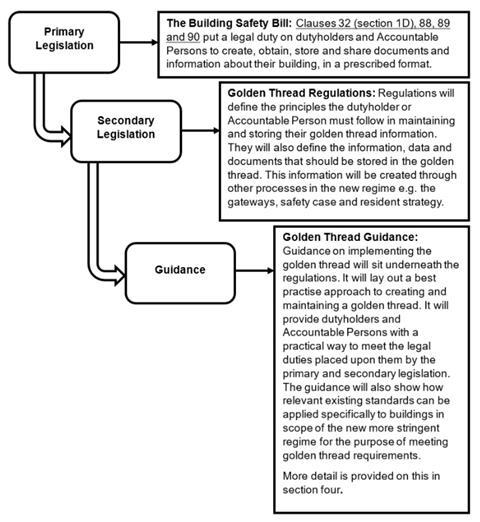Working group publishes details and definitions to ensure implementation of Hackitt’s recommendations
The group charged with steering the direction of the new building safety ”golden thread” has outlined its plans.
In her Building a Safer Future report, which was published in May 2018 in the wake of the Grenfell Tower disaster, Dame Judith Hackitt recommended the introduction of a “golden thread” to support those responsible for the design, construction and management of buildings.
The idea was to establish and maintain a holistic system to ensure that safety is taken into account at every stage in a building’s lifecycle. The government has committed to implementing Hackitt’s recommendations.
Now, a Building Regulations Advisory Committee (BRAC) working group, which brings together a cross-section of industry to support officials in developing the policy, has published a report setting out the golden thread definition and principles which will inform ongoing work in developing secondary legislation and guidance.
Golden thread in legislation

Source: BRAC report
The report describes the golden thread as “both the information that allows you to understand a building and the steps needed to keep both the building and people safe, now and in the future”.
This golden thread will hold the information that those responsible for the building require to show that it complies with all applicable building regulations during its construction and to provide evidence of meeting the requirements of the new building control route.
It will also include the information to identify, understand, manage and mitigate building safety risks in order to prevent or reduce the severity of the consequences of fire spread or structural collapse throughout the life cycle of a building
The report has laid out 10 principles to inform the secondary legislation (see below). These set out in more detail the responsibilities of dutyholders and accountable persons for the golden thread to meet government expectations. They include the need for information to be accurate and trusted, the way in which the new system will hold people accountable and the need to keep only relevant information.
The report also sets out the work of BRAC in supporting and challenging the industry to deliver a culture change. The government has made it clear that it is looking to the industry to lead that change.
The committee will help the industry to develop the digital competence needed to implement the golden thread and to promote the development of a culture in which safety is the core priority for those responsible for a building throughout its lifecycle
The golden thread principles
1. Accurate and trusted The dutyholder/accountable person/building safety managers and other relevant persons (eg contractors) must be able to use the golden thread to maintain and manage building safety and ensure compliance with building regulations. The regulator should also be able to use this information as part of their work to assess the compliance with building regulations, the safety of the building and the operator’s safety case report, including supportive evidence, and to hold people to account.
2. Residents feeling secure in their homes Residents will be provided with information from the golden thread – so that they have accurate and trusted information about their home. This will also support residents in holding accountable persons and building safety managers to account for building safety.
3. Culture change The golden thread will support culture change within the industry as it will require increased competence and capability, different working practices, updated processes and a focus on information management and control. The golden thread should be considered an enabler for better and more collaborative working.
4. Single source of truth The golden thread will bring all information together in a single place, meaning there is always a single source of truth. It will record changes, including the reason for change, evaluation of change, date of change, and the decision-making process.
5. Secure It must be secure, with sufficient protocols in place to protect personal information and control access to maintain the security of the building or residents. It should also comply with current GDPR legislation where required.
6. Accountable The golden thread will record changes, when these changes were made, and by whom. This will help improve accountability. The new regime is setting out clear duties for dutyholders and accountable persons for maintaining the golden thread information to meet the required standards.
7. Understandable/consistent The golden thread needs to support the user in their task of managing building safety and compliance with building regulations. The information must be clear, understandable and focused on the needs of the user. It should be presented in a way that can be understood – and used – by the users.
8. Simple to access The golden thread needs to support the user in their task of managing building safety and therefore the information must be accessible so that people can easily find the right information at the right time. This means that the information should be stored in a structured way (like a library) so people can easily find, update and extract the right information.
9. Longevity and shareability of information The information needs to be formatted in a way that can be easily handed over and maintained over the entire lifetime of a building. In practical terms, this is likely to mean that it needs to align with the rules around open data and the principles of interoperability – so that information can be handed over in the future and still be accessed.
10. Relevant/proportionate Preserving the golden thread does not mean everything about a building and its history needs to be kept and updated from inception to disposal. The objective is building safety and therefore, if information is no longer relevant to building safety, it does not need to be kept.




























No comments yet